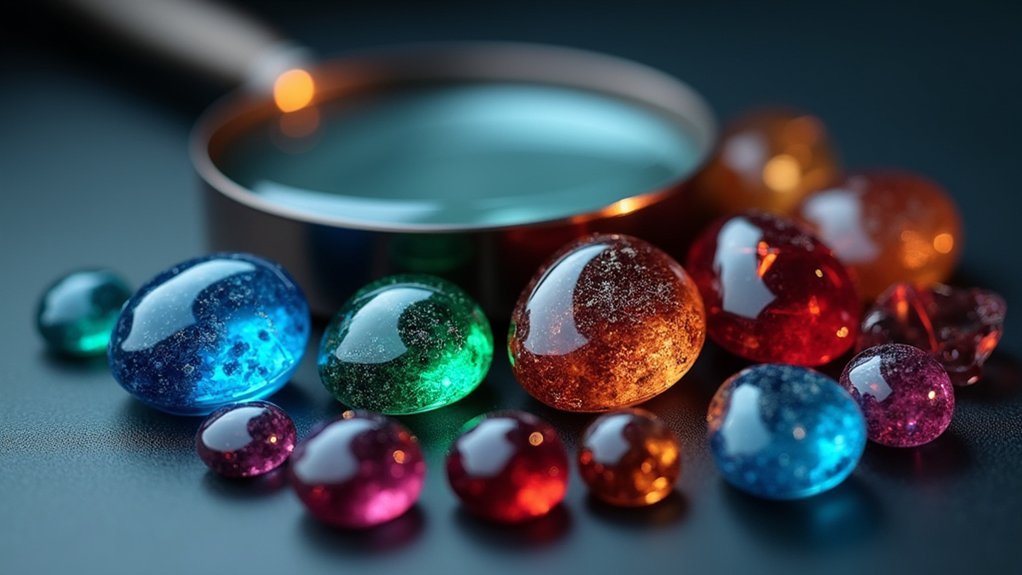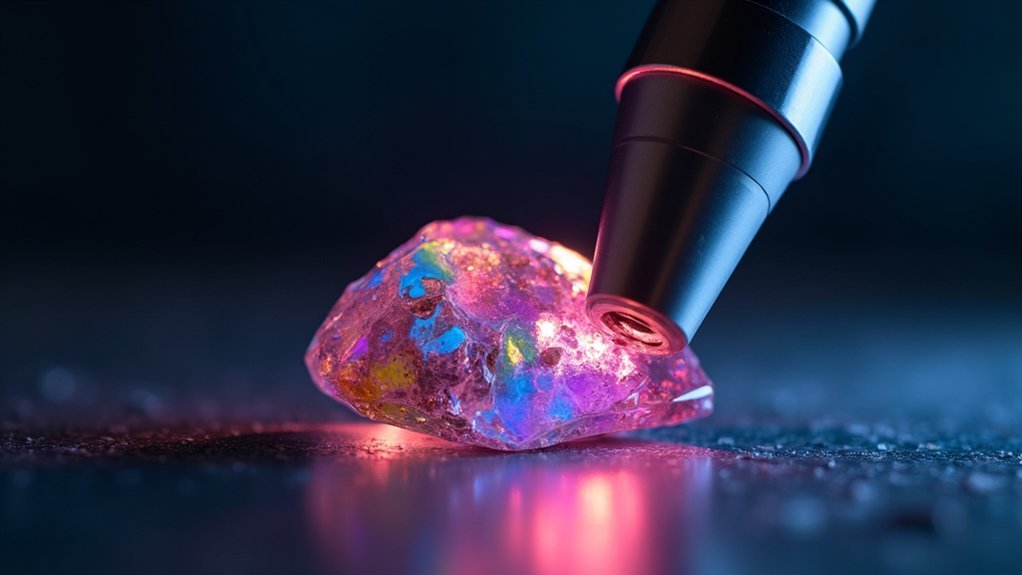To spot heat-treated stones, examine color uniformity and saturation, as natural gems show subtle variations while treated ones appear vibrant and consistent. Check for altered inclusions under magnification, which reveal thermal modification. Use spectroscopy to detect molecular changes from heating. Measure refractive index for shifts in crystal structure. Always verify with certification from respected labs like GIA or AGTA. These five methods will help you distinguish truly natural gemstones from their enhanced counterparts.
Color Analysis and Saturation Assessment

While natural gemstones often display subtle color variations, heat-treated stones typically exhibit unnaturally vibrant and consistent coloration.
When you assess a gemstone, look for uniformity in hue—heat treatment usually creates even coloration, whereas natural stones frequently show color zoning or uneven tones.
Pay attention to saturation levels too. Heat-treated stones generally showcase enhanced color intensity, particularly evident in sapphires’ deep blues and rubies’ vibrant reds.
You’ll notice that heat treatment eliminates undesirable brownish or grayish tints in stones like amethyst and aquamarine.
If you see gemstones with unusually bright, desirable shades—like the orange-yellow in treated citrine compared to its naturally paler counterpart—this often indicates heat treatment.
Your analysis should focus on whether the color appears too perfect or intense for the specific gemstone type.
Microscopic Examination of Inclusions
Since internal characteristics often tell the most reliable story about a gemstone’s history, examining inclusions under magnification provides definitive evidence of heat treatment.
When you’re investigating a stone, look for altered crystal structures and gas bubbles—telltale signs that heat has been applied.
Gemologists use high-powered microscopes to detect thermal effects like uneven color distribution or zoning. Heat-treated gems typically show improved clarity because the process eliminates many natural inclusions.
You’ll notice that needle-like rutile (silk) inclusions either disappear or transform greatly in treated stones.
Unheated stones generally retain their characteristic internal features intact.
During your microscopic examination, pay close attention to inclusion patterns—their presence, absence, or alteration reveals whether your gemstone maintains its natural state or has undergone enhancement through heat treatment.
Spectroscopy and Advanced Testing Methods

Beyond visual inspection with microscopes, today’s gemologists employ sophisticated analytical instruments that examine a stone’s molecular fingerprint.
Spectroscopy stands at the forefront of these advanced testing methods, analyzing how gemstones absorb and emit light to reveal telltale signs of heat treatments.
Spectroscopy unveils a gemstone’s secrets through its unique light interactions, exposing hidden heat treatment histories.
You’ll find Raman spectroscopy particularly effective at detecting molecular changes and altered inclusions that result from heating.
Meanwhile, infrared spectroscopy measures shifts in vibrational frequencies of molecular bonds—a clear indicator of treatment history.
For thorough authentication, gemologists often employ luminescence spectroscopy to identify modified trace elements introduced during treatment processes.
For the most reliable results, experts don’t rely on a single technique.
Refractive Index Measurement Techniques
When light passes through gemstones, it bends at specific angles—a property gemologists leverage through refractive index measurements to identify heat treatments. Your standard refractometer can reveal subtle RI value shifts resulting from alterations in crystal structure after heating.
- Precision is essential – Place your gem flat against the refractometer’s glass surface and watch how light interacts with the specimen, revealing whether it’s natural or modified.
- Know your benchmarks – Compare readings against established RI values (like sapphires’ 1.76-1.77 range) to spot heat-treated stones.
- Mind the variables – Temperature fluctuations and inclusions can affect your measurements, demanding careful calibration.
- Trust the numbers – Even slight deviations in refractive index can definitively distinguish natural gems from their heat-treated counterparts.
Consulting Certification Documentation and Gemological Labs

The three most reliable gatekeepers in gemstone authentication are the certification documents issued by respected gemological laboratories. When purchasing precious stones, always request thorough reports from institutions like the Gemological Institute of America (GIA) or American Gem Trade Association (AGTA).
Trust only respected gemological laboratories like GIA and AGTA when authenticating precious stones—their certification is your ultimate protection.
These documents explicitly state whether gems are “heat treated” or “untreated,” designations that greatly impact market value.
Look for detailed treatment status disclosures in certification documentation, which often include advanced imaging that reveals internal characteristics invisible to the naked eye. These scientific analyses provide transparency regarding any modifications the stone has undergone.
Remember that untreated gems typically command premium prices, reflecting their natural rarity.
Certification protects your investment while aligning seller claims with consumer expectations, ensuring you know exactly what you’re purchasing in an industry where authenticity determines value.
Frequently Asked Questions
How Do You Know if a Stone Is Heated?
You’ll know a stone is heated by examining it for color zoning, lack of natural inclusions, checking its refractive index, and using spectroscopy. You should consult a certified gemologist for definitive confirmation.
How to Tell if a Ruby Has Been Heat-Treated?
To tell if a ruby’s been heat-treated, you’ll want to examine it for diminished inclusions, unnaturally pure red color without purple/brown hues, reduced color zoning, altered “silk” patterns, or the presence of gas bubbles in specific areas.
What Is the Heat Test on Gemstones?
The heat test involves exposing gemstones to high temperatures to observe color changes. You’ll notice heat-treated stones showing uniform color, while untreated ones display natural variations and inclusions after the test.
Are Heated Gemstones Less Valuable?
No, heated gemstones aren’t automatically less valuable. While unheated stones can command premiums, a high-quality heated gemstone is often more valuable than a poor-quality unheated one. Market demand and overall quality determine value.
In Summary
You’ve now mastered the essential methods for identifying heat-treated stones. By examining color saturation, inspecting inclusions, utilizing spectroscopy, measuring refractive indices, and verifying certification documentation, you’ll confidently distinguish treated from natural gems. Remember, there’s no substitute for experience—the more stones you examine, the sharper your skills will become. When in doubt, don’t hesitate to consult professional gemological laboratories for definitive analysis.





Leave a Reply